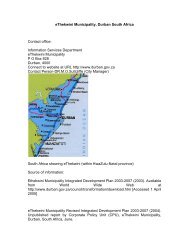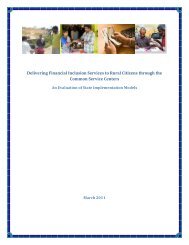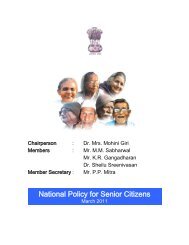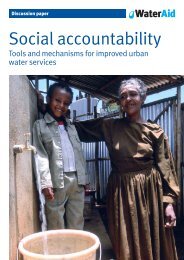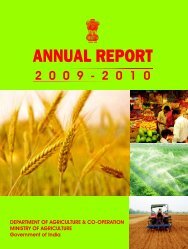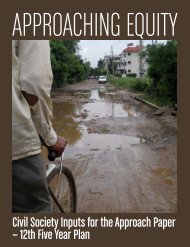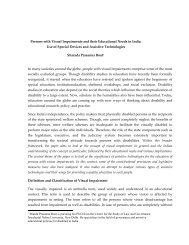See full case study - Governance in India
See full case study - Governance in India
See full case study - Governance in India
- No tags were found...
You also want an ePaper? Increase the reach of your titles
YUMPU automatically turns print PDFs into web optimized ePapers that Google loves.
<strong>Governance</strong> Knowledge CentrePromoted by Department of Adm<strong>in</strong>istrative Reforms and Public GrievancesM<strong>in</strong>istry of Personnel, Transparency Public Grievances and Accountabilityand PensionsGovernment of <strong>India</strong>Case StudyHealthTreat<strong>in</strong>g Tuberculosis: Operation AshaJune 2011Objective• Provide <strong>in</strong>tensive education on TB to patients, families and spread awareness of thedisease through tra<strong>in</strong>ed counsellors.• Ensure TB patients visit a counsell<strong>in</strong>g /treatment centre 60 times <strong>in</strong> 6 months to getmedication and control default rate• Monitor patients’ ts’ treatment via biometric attendance system so that they adhere to theregimen and take medic<strong>in</strong>es under supervision on a regular basis.Work<strong>in</strong>g DesignOperation Asha’s TB treatment strategy as compared to convention DOTS treatment yieldsbetter results due to the follow<strong>in</strong>g components:Education and TB awarenessThe counsellors carry out thorough education of patients and their families. They expla<strong>in</strong> thatTuberculosis is a bacterial <strong>in</strong>fection, <strong>full</strong>y curable, provided one gets the complete treatment.Once patients realise that miss<strong>in</strong>g doses can lead to Multi-Drug-Resistant Tuberculosis, whichis difficult and expensive to treat, they are much more motivated to adhere to the treatment.Counsell<strong>in</strong>g to patients, family members and communityThe counsellors are chosen from the community so that they can connect with the local peopleand TB patients would not be <strong>in</strong>timidated. There are 75 counsellors <strong>in</strong> total that perform therole of track<strong>in</strong>g patients and distribute medic<strong>in</strong>es on a regular basis <strong>in</strong> 135 centres across thecountry.Two week tra<strong>in</strong><strong>in</strong>g is provided to all counsellors <strong>in</strong> the head office on the disease and ways ofcounsell<strong>in</strong>g patients and observ<strong>in</strong>g patients <strong>in</strong> compliance with WHO recommended DOTSstrategy.They are stationed <strong>in</strong> the treatment centres 6 days a week to observe patients, distributemedic<strong>in</strong>es and check default <strong>case</strong>s with the help of biometric attendance system. Those centresthat do not have biometric devices have to fill out a standard form designed by GOI with thefollow<strong>in</strong>g details: Patient’s name, Phase of treatment (weeks/months) and Medic<strong>in</strong>eprescription (number of dosage).4Researched and documented byOneWorld Foundation <strong>India</strong>
<strong>Governance</strong> Knowledge CentrePromoted by Department of Adm<strong>in</strong>istrative Reforms and Public GrievancesM<strong>in</strong>istry of Personnel, Transparency Public Grievances and Accountabilityand PensionsGovernment of <strong>India</strong>Case StudyHealthTreat<strong>in</strong>g Tuberculosis: Operation AshaJune 2011There are two ways that counsellors f<strong>in</strong>d TB patients. Firstly, Operation Asha has l<strong>in</strong>ked itsproject with dispensaries and government hospitals through which they can be monitored andcontacted. Secondly, the counsellors physically <strong>in</strong>teract with people that carry symptoms suchas cough<strong>in</strong>g for three weeks, fatigue, weight loss etc; and br<strong>in</strong>g them to the hospital for TBsputum test<strong>in</strong>g. If tested positive then he/she is brought to the centre for DOTS treatment andcare<strong>full</strong>y observed till he/she is <strong>full</strong>y compared.Counsellors advise patients’ family members to love and care for them; and give propernutrition. Patients are taught how to prevent <strong>in</strong>fection to others by simple precautions. Theyare rem<strong>in</strong>ded that to take immediate action when they miss a s<strong>in</strong>gle dose. The counsellor visitsthe patient’s house to repeat the education. They are also told about the side- effects of themedic<strong>in</strong>es, and how it can be m<strong>in</strong>imised.All counsellors lors visit patients daily, expla<strong>in</strong><strong>in</strong>g to people what the disease is, how the treatmentworks and that there is a complete solution available. They tell them where they can f<strong>in</strong>d DOTStreatment locally through Operation ASHA. The treatment centres are placed with<strong>in</strong> thecommunities where the patients live and due to easy accessibility to medical treatment, thedetection rate has <strong>in</strong>creased substantially and the dropout rate has reduced by 20-30 times.As of now, counsellors of few centres are be<strong>in</strong>g paid Rs 3300 per month for their services andthe rest are gett<strong>in</strong>g <strong>in</strong>centive based salary. This is a pilot test conducted by MIT social research<strong>in</strong>stitute to f<strong>in</strong>d out which type of payment will improve counsellors performance: a basicsalary or an <strong>in</strong>centive salary. The <strong>in</strong>centive salary will be paid based on performance wherethey will get a bonus for each new patient detected, and a bonus for zero default.Figure 1: Counsellor Jyoti with TB patient.Source: http://opasha.org/5Researched and documented byOneWorld Foundation <strong>India</strong>
<strong>Governance</strong> Knowledge CentrePromoted by Department of Adm<strong>in</strong>istrative Reforms and Public GrievancesM<strong>in</strong>istry of Personnel, Transparency Public Grievances and Accountabilityand PensionsGovernment of <strong>India</strong>Case StudyHealthTreat<strong>in</strong>g Tuberculosis: Operation AshaJune 2011of the project.2. Free services: TB treatment is cont<strong>in</strong>uous for 6 months and every patient is to be physicallyobserved to avoid defaults or else there is a possibility to contract MDR-TB that is anti-drugresistant and not easy to cure. This is not possible for those that are poor and OperationAsha has provided all services: sputum test<strong>in</strong>g, DOTS services and medic<strong>in</strong>es free of costfor all urban slum dwellers.3. Easy accessibility: All DOTS treatment centres are owned by community persons andcounsellors are chosen from the community hence, TB patients do not hesitate to visitthem. They feel comfortable and connect to them at ease. This approach has broken downbarriers between the patient and other community members where by the patient doesn’tfeel victimised or discrim<strong>in</strong>ated <strong>in</strong> society.4. Automated patient attendance and treatment monitor<strong>in</strong>g: Currently the Delhi treatmentcentres are supported with biometric attendance system to ensure 100% patientscompliance to the treatment. Every day after the medic<strong>in</strong>al dosage, the patient scanshis/her f<strong>in</strong>ger on the scanner connected to the netbook that comprises of patient database.The names of unattended patients listed via SMS is sent to the counsellor’s mobile phoneconnected to the netbook. This helps the counsellors to follow up with the absentees attheir homes, give them medic<strong>in</strong>es and scan their f<strong>in</strong>gers on the system. This processenables the centres to keep a complete check on the patients on real time basis treatmentand <strong>full</strong>y cure them.ConclusionTuberculosis is rampant <strong>in</strong> the world and is most prom<strong>in</strong>ent <strong>in</strong> urban slums <strong>in</strong> <strong>India</strong>. Althoughthe costs are very low, Operation Asha is required to scale up operations and build capacity torun the project <strong>in</strong> other states as well. It also has to <strong>full</strong>y prepare to overcome two challenges: a)TB <strong>in</strong>fection can spread to 12 people and b) MDR-TB is difficult to treat and expensive too.To overcome these challenges, the organisation is mov<strong>in</strong>g forward <strong>in</strong> spread<strong>in</strong>g TB awarenesswith its community based efforts and supervis<strong>in</strong>g patients’ treatment at the local level. Withsimilar level of commitment and dedication to the cause, we can hope Operation Asha toalleviate the poor from this deadly disease.sResearch was carried out by OneWorld Foundation <strong>India</strong> (OWFI), <strong>Governance</strong> Knowledge Centre (GKC) team.Documentation was created by Research Associate, Attrika HazarikaFor further <strong>in</strong>formation, please contact Naimur Rahman, Director, OWFI, at owsa@oneworld.net8Researched and documented byOneWorld Foundation <strong>India</strong>
<strong>Governance</strong> Knowledge CentrePromoted by Department of Adm<strong>in</strong>istrative Reforms and Public GrievancesM<strong>in</strong>istry of Personnel, Transparency Public Grievances and Accountabilityand PensionsGovernment of <strong>India</strong>Case StudyHealthTreat<strong>in</strong>g Tuberculosis: Operation AshaJune 2011• Community centres <strong>in</strong>frastructure• Medic<strong>in</strong>es• Counsellors salary• Biometric devices• Otherb. Are services provided under Operation Asha affordable? If so, how much dothey cost?4. The project has been launched <strong>in</strong> 14 cities and 6 states. How many TB patientshave been treated by Operation Asha to date? Per month?5. In what ways is the project successful? What is particularly unique about thismodel of address<strong>in</strong>g TB?6. Were there any challenges faced dur<strong>in</strong>g project implementation? If yes, then whatwere they and how were they overcome?7. What is the strategy for further promotion of awareness/upscal<strong>in</strong>g of the project?10Researched and documented byOneWorld Foundation <strong>India</strong>




